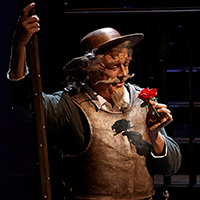 Furlanetto as Don Quichotte.
Furlanetto as Don Quichotte. On Sunday afternoon (May 11) I arrived at Toronto’s Four Seasons Centre hoping for nothing more than a pleasantly sentimental operatic experience, and came away very much impressed by what I heard and saw. This Quichotte went from strength to strength: it was a chain with no weak link.
And the other principals were just as strong. As Sancho Panza, the rich-voiced baritone Quinn Kelsey brought a buffoonish energy to the role of Quichotte’s sidekick. There was a touching chemistry between the two men (to invoke current slang, it was a fine “bromance”), and they played off each other brilliantly. Kelsey’s Panza was goofy, lazy and unheroic in every way – but when he scolds the townsfolk for their mockery of Quichotte, he rises to the occasion with conviction.
Anita Rachvelishvili also had plenty of conviction about her as Quichotte’s object of devotion, Dulcinée. Her powerful and polished mezzo voice was just right to portray a vain and headstrong beauty. Yet although she ultimately turns down Quichotte’s hand in marriage, even she is moved by the old man’s idealism and sincerity.
Making her COC debut, director Linda Brovsky delivered a taut and surefooted staging. In her hands, the characters were both archetypes and three-dimensional people. Similarly, conductor Johannes Debus brought Massenet’s score to life, with a vivid and detailed performance from his orchestra and chorus.
Designer Donald Eastman’s scenery (rented from the Seattle Opera) was dominated by gigantic books and quill pens, and effectively underscored the literary origins of the opera. I suppose this metaphorical approach made the staging a “Konzept” production. But it was such a straightforward and agreeable Konzept that even the most conservative opera fans surely couldn’t have found it difficult or offensive.
Indeed, there was a directness about the whole show that reminded me of the kind of productions the COC used to mount back in Lotfi Mansouri’s day. I found it pleasant to be transported back to a simpler time, before opera became the cerebral art form it is today. (That said, I wouldn’t want to permanently go back to the 1980s. Would you?)
© Colin Eatock 2014
 RSS Feed
RSS Feed

